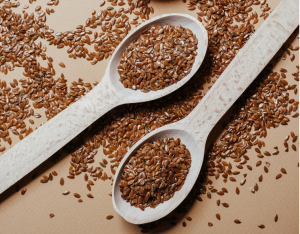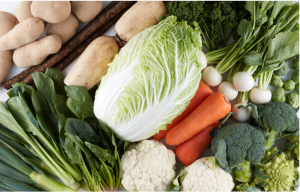 Smoothies aren’t just a tasty way to pack in nutrients—they can also be powerful tools for supporting your energy, mental clarity, and hormonal balance. With the right ingredients, your daily blend can become more than a snack or meal—it can help you thrive throughout your day.
Smoothies aren’t just a tasty way to pack in nutrients—they can also be powerful tools for supporting your energy, mental clarity, and hormonal balance. With the right ingredients, your daily blend can become more than a snack or meal—it can help you thrive throughout your day.
Energy
Let’s start with energy. Ingredients like bananas, dates, and oats offer natural carbohydrates for sustained fuel, while leafy greens like spinach or kale provide B vitamins that help your body convert food into energy. Adding a spoonful of nut butter or hemp seeds introduces healthy fats and protein to keep blood sugar steady.
Focus
 When it comes to focus, your smoothie can do even more. Adaptogens like maca root or ashwagandha may support cognitive function and reduce stress, helping you stay clear-headed. A pinch of cinnamon can also help stabilize blood sugar and prevent that mid-afternoon brain fog.
When it comes to focus, your smoothie can do even more. Adaptogens like maca root or ashwagandha may support cognitive function and reduce stress, helping you stay clear-headed. A pinch of cinnamon can also help stabilize blood sugar and prevent that mid-afternoon brain fog.
Hormone Support
 For hormone support, small additions go a long way. Flaxseeds are rich in lignans and omega-3s, both of which are known to support hormone regulation. You can also include hormone-loving foods like berries (rich in antioxidants) and leafy greens (to aid in detoxification and estrogen balance).
For hormone support, small additions go a long way. Flaxseeds are rich in lignans and omega-3s, both of which are known to support hormone regulation. You can also include hormone-loving foods like berries (rich in antioxidants) and leafy greens (to aid in detoxification and estrogen balance).
Creating a smoothie that fuels your flow is about more than just ingredients—it’s about intention. With a little planning, your morning ritual can support not just your physical health, but your mental and emotional balance too.
Need a recipe to get started? Try blending:
- 1 banana
- 1 tbsp flaxseeds
- 1 handful of spinach
- 1 tsp maca powder
- 1 tbsp almond butter
- 1 cup almond milk
- Ice (optional)
 And keep an eye out—we’re kicking off a brand-new Smoothie Challenge later this month of May! Whether you’re new to blending or ready to level up your smoothie game, this is the perfect time to get inspired, energized, and supported. Stay tuned for sign-up details coming soon! You can also email to get signed up! The best part? It’s totally FREE!
And keep an eye out—we’re kicking off a brand-new Smoothie Challenge later this month of May! Whether you’re new to blending or ready to level up your smoothie game, this is the perfect time to get inspired, energized, and supported. Stay tuned for sign-up details coming soon! You can also email to get signed up! The best part? It’s totally FREE!


 In a fast-paced world where high intensity workouts and fitness trackers dominate the conversation, it’s easy to overlook one of the simplest and most effective forms of exercise:
In a fast-paced world where high intensity workouts and fitness trackers dominate the conversation, it’s easy to overlook one of the simplest and most effective forms of exercise:  Your heart is a hardworking muscle, and like any muscle, it gets stronger with consistent use. Regular walking helps improve cardiovascular function in several key ways. It increases circulation, strengthens the heart muscle, and helps regulate blood pressure.
Your heart is a hardworking muscle, and like any muscle, it gets stronger with consistent use. Regular walking helps improve cardiovascular function in several key ways. It increases circulation, strengthens the heart muscle, and helps regulate blood pressure. Beyond heart health, walking also supports one of the most overlooked areas of wellness:
Beyond heart health, walking also supports one of the most overlooked areas of wellness:  Walking also plays an important role in supporting
Walking also plays an important role in supporting  Walking is more than just exercise—it’s
Walking is more than just exercise—it’s  Your body doesn’t always need intensity—it needs
Your body doesn’t always need intensity—it needs  As the days grow longer and the earth awakens from winter’s slumber, the
As the days grow longer and the earth awakens from winter’s slumber, the  To align with this energy, consider cleansing your space, both physically and energetically. Open the windows, clear out clutter, and invite in fresh air and light. In your wellness routine, focus on nourishing seasonal foods, grounding movement like yoga or walking, and mindful practices such as journaling or meditation.
To align with this energy, consider cleansing your space, both physically and energetically. Open the windows, clear out clutter, and invite in fresh air and light. In your wellness routine, focus on nourishing seasonal foods, grounding movement like yoga or walking, and mindful practices such as journaling or meditation. Spring is a season of new opportunities, fresh energy, and expansion. Take this time to set intentions, embrace change, and welcome the possibilities ahead. What seeds of growth will you plant this season?
Spring is a season of new opportunities, fresh energy, and expansion. Take this time to set intentions, embrace change, and welcome the possibilities ahead. What seeds of growth will you plant this season? Join Me for a Free Online Yoga & Meditation Class!
Join Me for a Free Online Yoga & Meditation Class! Leafy Greens & Cruciferous Veggies
Leafy Greens & Cruciferous Veggies By nourishing your body and mind with the right foods and supplements, you can stay
By nourishing your body and mind with the right foods and supplements, you can stay  1. Morning Breathers: Start your day with five minutes of quiet breathing. Sit by the window with your favourite warm drink, taking slow, deep breaths. This small ritual can set a peaceful tone for the day. Repeat during the day whenever necessary.
1. Morning Breathers: Start your day with five minutes of quiet breathing. Sit by the window with your favourite warm drink, taking slow, deep breaths. This small ritual can set a peaceful tone for the day. Repeat during the day whenever necessary.
 Ingredients:
Ingredients: I love when September rolls around; it’s often seen as a fresh start, making it the perfect time to reset routines and focus on self-improvement. As summer winds down and the structure of fall begins, many people (myself included) seek to re-establish balance and set new goals for the months ahead. Whether you’re returning to work, school, or simply refocusing after vacation, September provides a natural opportunity for growth and change. Here are some popular areas to explore below.
I love when September rolls around; it’s often seen as a fresh start, making it the perfect time to reset routines and focus on self-improvement. As summer winds down and the structure of fall begins, many people (myself included) seek to re-establish balance and set new goals for the months ahead. Whether you’re returning to work, school, or simply refocusing after vacation, September provides a natural opportunity for growth and change. Here are some popular areas to explore below. Fitness goals: September is also a great time to revisit fitness goals. With the cooler weather, outdoor activities like hiking, running, or biking become more enjoyable for those who struggle in high temperatures. Set realistic and achievable targets, whether it’s increasing your daily steps or trying a new workout routine. The key is consistency—find activities you enjoy so that maintaining your fitness routine feels less like a chore and more like a lifestyle change.
Fitness goals: September is also a great time to revisit fitness goals. With the cooler weather, outdoor activities like hiking, running, or biking become more enjoyable for those who struggle in high temperatures. Set realistic and achievable targets, whether it’s increasing your daily steps or trying a new workout routine. The key is consistency—find activities you enjoy so that maintaining your fitness routine feels less like a chore and more like a lifestyle change. Are you feeling inclined to create a new habits this fall? Whether it’s waking up earlier, eating healthier, or improving productivity or time management, September is the perfect time to establish new habits. Focus on one or two key changes, and give yourself grace to gradually adapt. Small, consistent actions lead to lasting self-improvement.
Are you feeling inclined to create a new habits this fall? Whether it’s waking up earlier, eating healthier, or improving productivity or time management, September is the perfect time to establish new habits. Focus on one or two key changes, and give yourself grace to gradually adapt. Small, consistent actions lead to lasting self-improvement. But instead of focusing on what’s slipping away, embrace the remaining days by making the most of them! This bucket list is designed to help you capture those last summer moments, whether it’s relaxing by the water or enjoying outdoor adventures.
But instead of focusing on what’s slipping away, embrace the remaining days by making the most of them! This bucket list is designed to help you capture those last summer moments, whether it’s relaxing by the water or enjoying outdoor adventures. 

 Smoothies make an ideal breakfast choice during summer, especially when you’re in a hurry to get out the door. They’re quick to prepare, light, and refreshing, perfect for hot mornings.
Smoothies make an ideal breakfast choice during summer, especially when you’re in a hurry to get out the door. They’re quick to prepare, light, and refreshing, perfect for hot mornings.